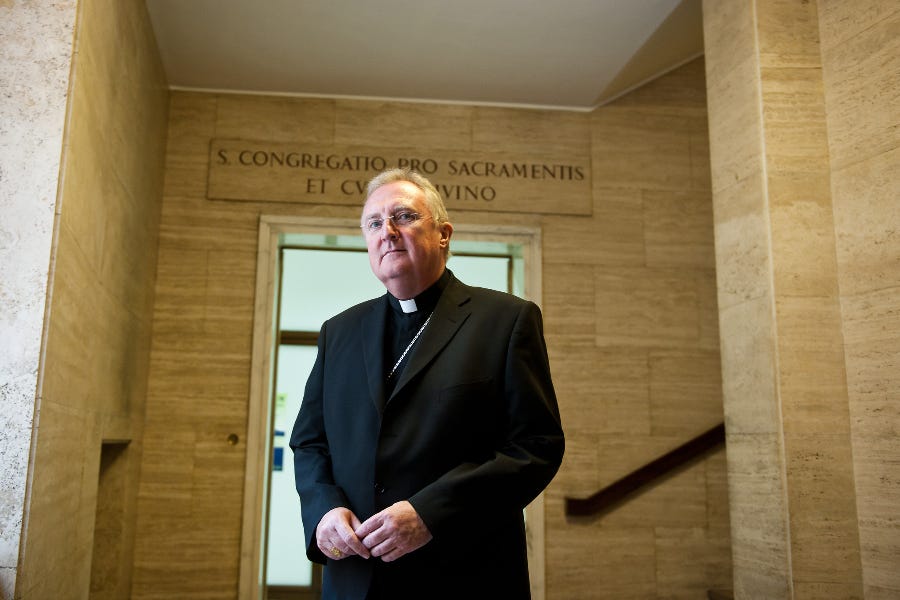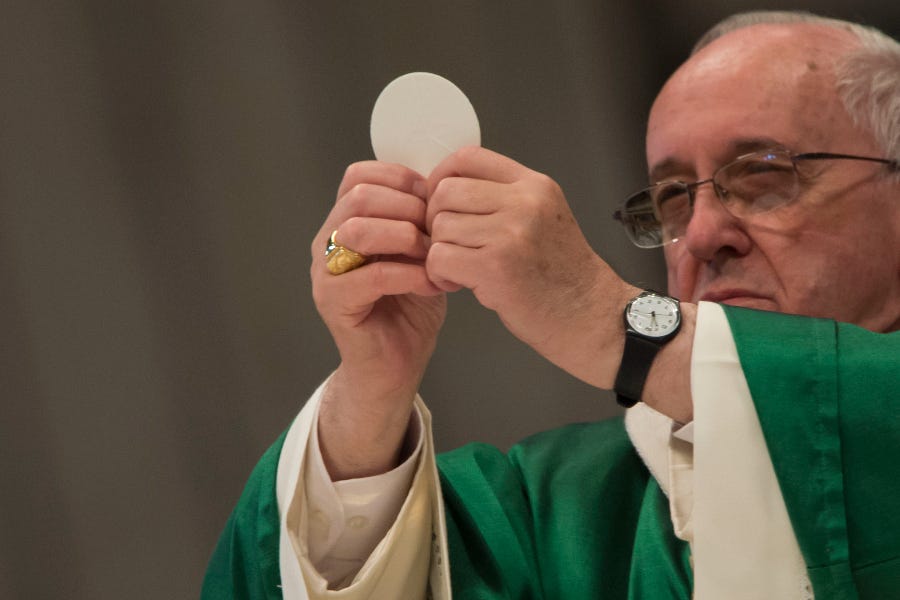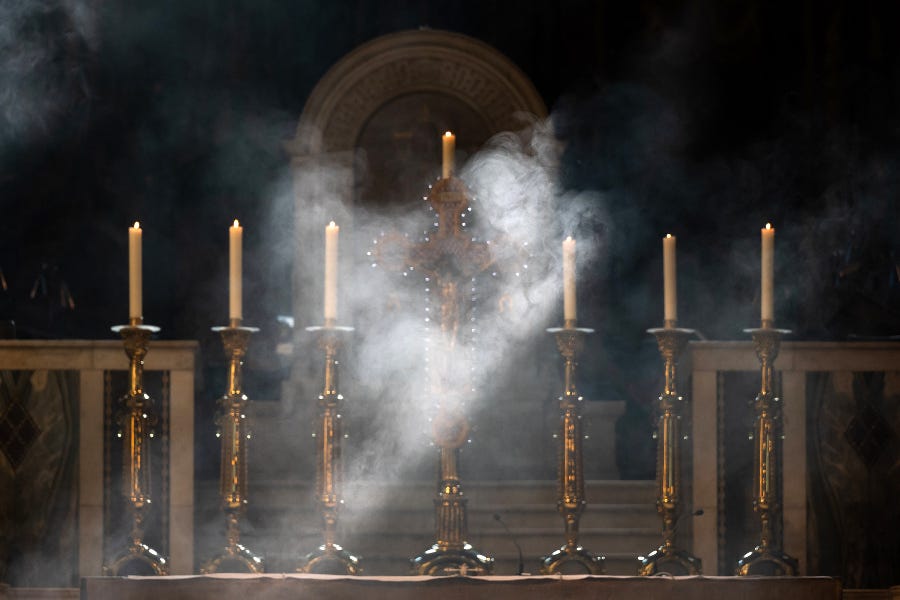
What does Pope Francis say in his new apostolic letter on the liturgy?
A Pillar Explainer
Pope Francis released a new apostolic letter on the liturgy on Wednesday. The letter, Desiderio desideravi, addresses “the liturgical formation of the People of God.”
So what does it say? What’s the context? And how is it likely to be received? The Pillar explains:
What the apostolic letter says
Desiderio desideravi was released on June 29, the feast of Sts. Peter and Paul, one of the most important days in the Vatican calendar. The pope, the successor of St. Peter, traditionally celebrates Mass in St. Peter’s Basilica on the feast day and blesses woolen garments known as palliums to be given to metropolitan archbishops as a sign of communion.
The apostolic letter’s title is taken from a passage in St. Luke’s Gospel describing the Last Supper, when Jesus instituted the Eucharist. In Luke 22:15, Jesus tells his disciples: “I have earnestly desired [desiderio desideravi] to eat this Passover with you before I suffer.”
The letter, around 11,000 words in English and broken into 65 numbered paragraphs, is addressed to bishops, priests, deacons, consecrated men and women, and laypeople. In other words, to all Catholics. The pope underlines this in his opening sentence, saying that wants to share “some reflections on the liturgy” with all Church members.
Pope Francis says that his observations are not “exhaustive” and he simply wants “to offer some prompts or cues for reflections that can aid in the contemplation of the beauty and truth of Christian celebration.”
The letter opens with a reflection on the Last Supper. The pope then recalls the Second Vatican Council’s impact on the liturgy. He says that the 1962-65 ecumenical council enabled “the rediscovery of a theological understanding of the Liturgy and of its importance in the life of the Church.”
“With this letter I simply want to invite the whole Church to rediscover, to safeguard, and to live the truth and power of the Christian celebration,” he writes.
He then suggests that the liturgy is an “antidote” to “distorted forms of Christianity,” including Gnosticism and neo-Pelagianism, two dangers he described at length in his 2013 apostolic exhortation Evangelii gaudium.
The pope appeals for a rediscovery of “the beauty of the truth of the Christian celebration,” noting that this does not mean “the search for a ritual aesthetic which is content by only a careful exterior observance of a rite or is satisfied by a scrupulous observance of the rubrics.”
He urges Catholics to cultivate a sense of “astonishment at the paschal mystery.”
The pope says that Vatican II’s objective was to help Catholics to “live completely the liturgical action.” He says that this requires liturgical formation because many modern people have “lost the capacity to engage with symbolic action, which is an essential trait of the liturgical act.”
Pope Francis argues that divisions over the liturgical reforms following the Council are “primarily ecclesiological.”
“I do not see how it is possible to say that one recognizes the validity of the Council — though it amazes me that a Catholic might presume not to do so — and at the same time not accept the liturgical reform born out of Sacrosanctum concilium, a document that expresses the reality of the Liturgy intimately joined to the vision of Church so admirably described in Lumen gentium,” the pope writes.
He adds that this was why he issued Traditionis custodes, his 2021 apostolic letter placing tight restrictions on “the use of the Roman Liturgy prior to the reform of 1970.”
The pope then outlines his vision of “a serious and dynamic liturgical formation,” drawing on the work of Romano Guardini (1885–1968), the Italian-born German theologian who wrote the influential book “The Spirit of the Liturgy.”
Pope Francis underlines that the Eucharistic celebration should be at the heart of seminary life. He says that “in addition to a program of studies, [seminaries] must also offer the possibility of experiencing a celebration that is not only exemplary from a ritual point of view, but also authentic and alive.”
He explains that the liturgy is not primarily about knowledge, but “about praise, about rendering thanks for the Passover of the Son whose power reaches our lives.” He then considers ways in which Catholics can be “initiated into symbolic language.”
The pope offers an extended reflection on the ars celebrandi, or art of celebrating the liturgy. He cautions against both “rubrical mechanism” and “imaginative — sometimes wild — creativity.” He stresses the importance of knowledge, preparation, and silence.
He notes that laypeople too can contribute to refining the ars celebrandi through their own words and gestures during Mass.
The pope says he has seen various negative “models” of presiding at the liturgy during his travels, including “rigid austerity or an exasperating creativity, a spiritualizing mysticism or a practical functionalism, a rushed briskness or an overemphasized slowness, a sloppy carelessness or an excessive finickiness, a superabundant friendliness or priestly impassibility.”
He says that the common flaw is “a heightened personalism of the celebrating style which at times expresses a poorly concealed mania to be the center of attention.”
“Often this becomes more evident when our celebrations are transmitted over the air or online, something not always opportune and that needs further reflection,” he remarks.
In conclusion, Pope Francis invites Catholics to rediscover the richness of Sacrosanctum concilium, Vatican II’s Constitution on the Sacred Liturgy.
“For this reason we cannot go back to that ritual form which the Council fathers, cum Petro et sub Petro [with Peter and under Peter], felt the need to reform, approving, under the guidance of the Holy Spirit and following their conscience as pastors, the principles from which was born the reform,” he writes.
“The holy pontiffs St. Paul VI and St. John Paul II, approving the reformed liturgical books ex decreto Sacrosancti Œcumenici Concilii Vaticani II [by decree of Vatican II], have guaranteed the fidelity of the reform of the Council. For this reason I wrote Traditionis custodes, so that the Church may lift up, in the variety of so many languages, one and the same prayer capable of expressing her unity.”
He underlines his determination “that this unity be re-established in the whole Church of the Roman Rite.”
After an exhortation to “abandon our polemics” and “safeguard our communion,” the letter ends with a quotation from the pope’s namesake St. Francis of Assisi.

What’s the context?
In the first years of his pontificate, Francis appeared to pay little attention to the liturgy. But in the past year or so, he seems to have made it a high priority.
Days after he returned from the Vatican after colon surgery in July 2021, he issued Traditionis custodes (“Guardians of the tradition”). In an accompanying letter to the world’s bishops, he explained that he was issuing the document “in defense of the unity of the Body of Christ.”
The pope said he was “saddened that the instrumental use of Missale Romanum of 1962 is often characterized by a rejection not only of the liturgical reform, but of the Vatican Council II itself, claiming, with unfounded and unsustainable assertions, that it betrayed the Tradition and the ‘true Church.’”
He argued that “to doubt the Council is to doubt the intentions of those very Fathers who exercised their collegial power in a solemn manner cum Petro et sub Petro in an ecumenical council, and, in the final analysis, to doubt the Holy Spirit himself who guides the Church.”
The apostolic letter was followed shortly before Christmas 2021 by a document known as the Responsa ad dubia (“Answers to doubts”), addressing questions about the implementation of Traditionis custodes.
The text, issued by the Congregation for Divine Worship and the Discipline of the Sacraments, answered 11 questions with the words “affirmative” or “negative,” followed by a brief explanation. The document was seen as tightening the restrictions contained in Traditionis custodes.
As Traditionis custodes entered immediately into force on the day of its publication, the world’s bishops had no preparation time to consider how to enact its principles in their dioceses. They have therefore responded at varying speeds. Nearly a year after the letter’s release, many U.S. dioceses are still working on their plans.
In May this year, Archbishop Arthur Roche, the prefect of the Dicastery for Divine Worship and the Discipline of the Sacraments, told the Spanish magazine Omnes that his dicastery was preparing a document on liturgical formation.
Roche, who will receive a cardinal’s red hat on Aug. 27, said there was a lack of liturgical formation in the contemporary Church.
“It is very interesting to remember that in the years before the Council there was the liturgical movement, with a patristic, biblical, ecumenical foundation; and the Council offered the possibility of a renewal of the Church, also in what concerns the liturgy,” he commented.
“I think that at this moment the only thing that is being sought is the fulfillment of the rubrics of the Liturgy, and that seems to me to be a bit poor. Theologically, the reason was the celebration of the Mystery.”
“That is why two years ago the Holy Father asked this Congregation to hold a plenary meeting of all its members to discuss liturgical formation in the whole Church: from the bishops to the priests to the laity.”
He said that the text would address questions such as “What do we do when we come together every Sunday for this celebration? Not just an obligation to do something every week, but what do we do? What do we celebrate at that time?”
How is it likely to be received?
The reception of Desiderio desideravi is likely to follow the same broad lines as Traditionis custodes and the Responsa ad dubia. It will be welcomed by those who esteem the vernacular liturgy introduced in the wake of the Second Vatican Council and criticized by adherents of the Traditional Latin Mass.
Traditionalists may appreciate, however, some parts of the letter and its overall emphasis on the importance of the liturgy.













I'd be interested in a (theological? canonical?) analysis of the way that Pope Francis loops the Novus Ordo mass in all its particulars into the larger category of the Second Vatican Council.
It seems like there's a lot going on in phrases like "accept the liturgical reform born out of Sacrosanctum Concilium."
I'm not a theologian or liturgical expert, but it seems to me that one can distinguish between the following:
1) An outright rejection of one or more of the V2 documents
2) An outright rejection of the validity of the novus ordo mass
3) A belief that the post-V2 liturgical form was deficient in some way (aesthetically, didactically, theologically, perhaps even in its fidelity to Sacrosanctum Concilium), despite being well intentioned and in no way leading to sacramental invalidity
4) A preference for the traditional mass
5) A belief that the traditional mass still has any value at all
It seems to me that all those things are in danger of being conflated.
It is sad that I have reached a point where an apostolic letter by the pope makes me feel only a foreboding sense of "What now?" If the letter merely says that we should neither be hypocritically functional nor falsely mystical, I am relieved. I expected that it would tell me what time signature the offertory hymn must have.